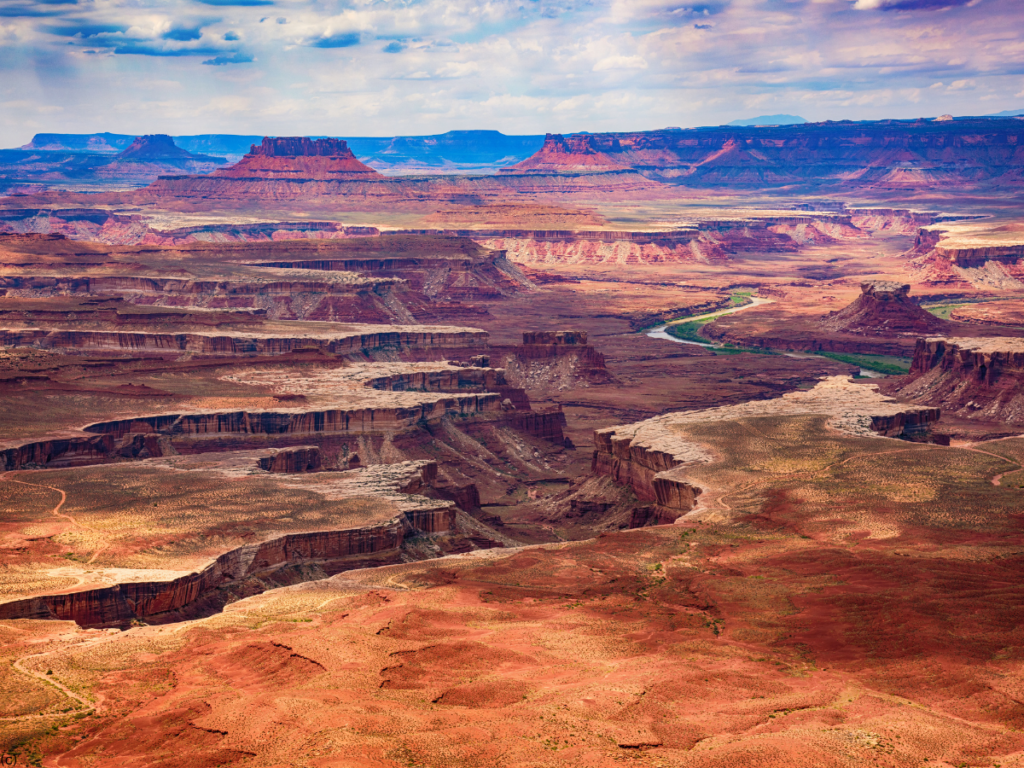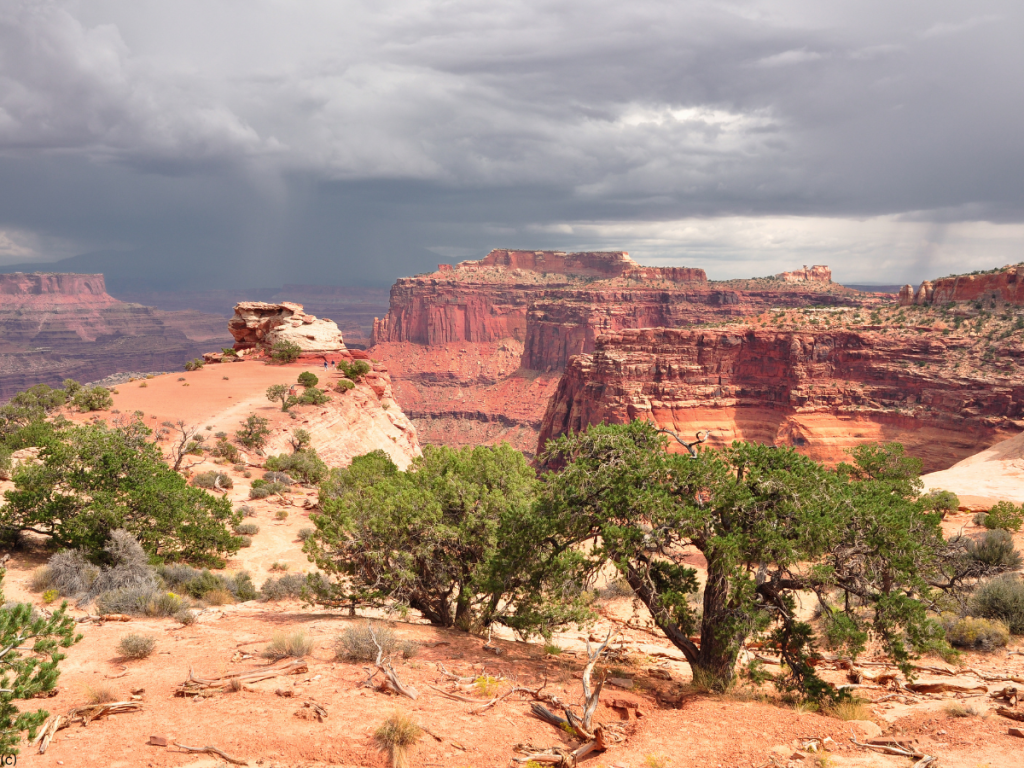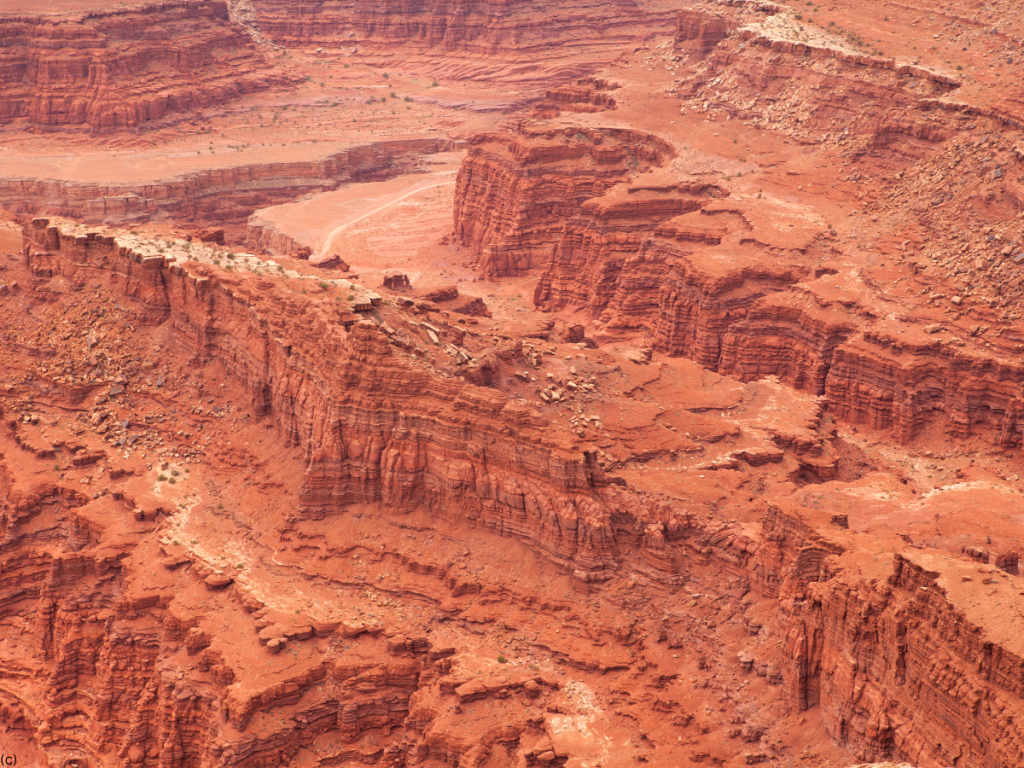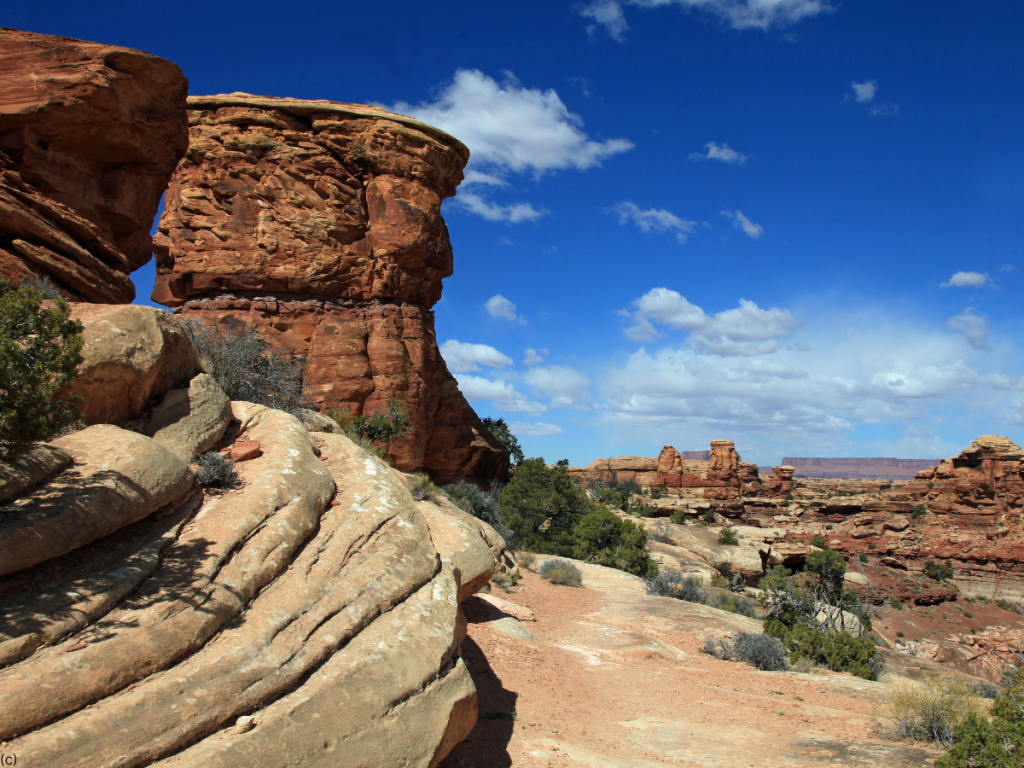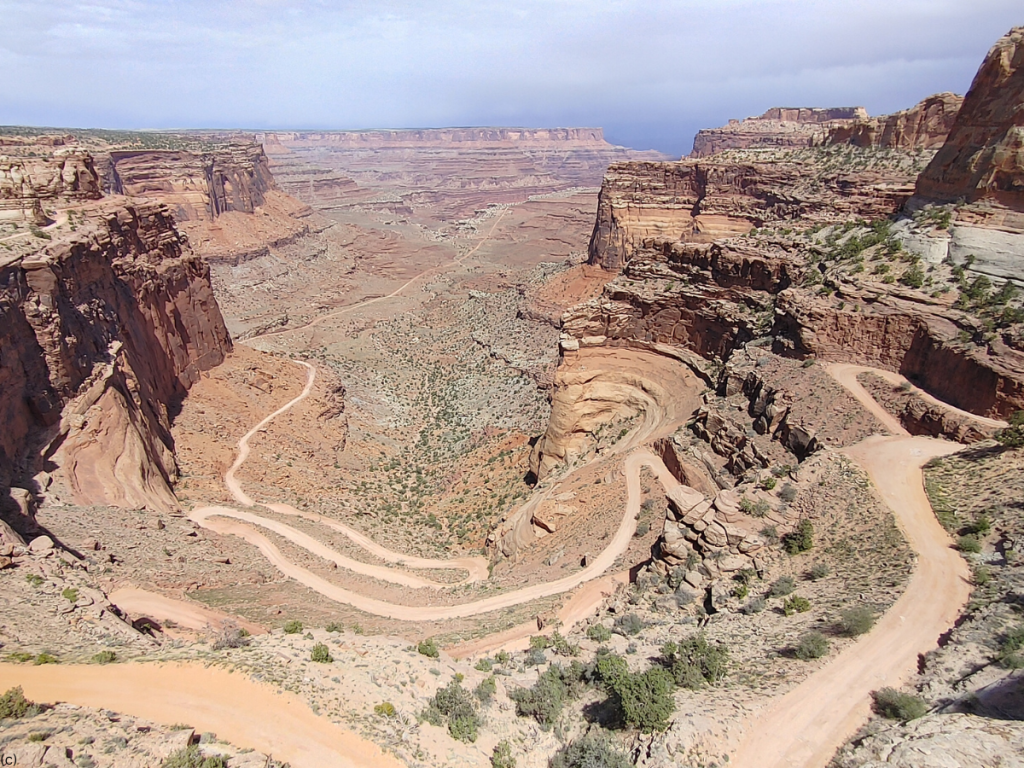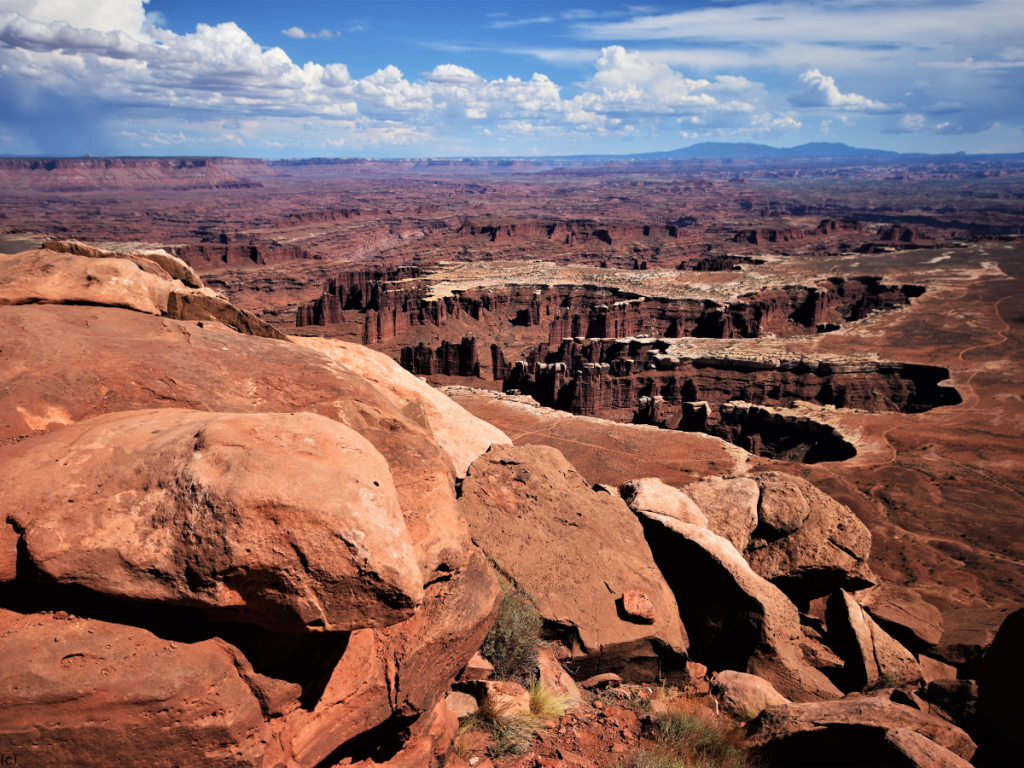
Canyonlands National Park, located in southeastern Utah, is a treasure trove of rugged landscapes, towering mesas, deep canyons, and expansive vistas that stretch out as far as the eye can see. The park, established in 1964, covers over 330,000 acres of high desert terrain and is divided into four distinct districts: Island in the Sky, The Needles, The Maze, and the rivers that cut through the landscape, the Green and Colorado Rivers. Each district offers its own unique experiences and breathtaking scenery, making Canyonlands a must-visit destination for nature lovers, outdoor enthusiasts, and anyone looking to experience the raw beauty of the American Southwest.
In this article, we will explore the major highlights of Canyonlands National Park, focusing on the most accessible and popular areas, as well as some lesser-known spots that offer solitude and adventure.
1. Island in the Sky District
Island in the Sky is the most visited district of Canyonlands National Park, and for good reason. It sits atop a massive mesa with sheer cliffs that drop 1,000 feet to the canyons below, offering panoramic views that are simply awe-inspiring. The district is easily accessible from the town of Moab, making it a popular destination for day trips and short visits.
a. Mesa Arch
One of the most iconic sights in the Island in the Sky district is Mesa Arch. This natural stone arch is perched on the edge of a cliff and frames the dramatic landscape below, making it a favorite spot for photographers, especially at sunrise. The hike to Mesa Arch is relatively easy, about 0.5 miles round trip, and is suitable for visitors of all ages.
At sunrise, the arch glows with a golden hue as the first light of day illuminates the canyons beyond, creating a scene that is nothing short of magical. Even if you’re not a photographer, witnessing the sunrise at Mesa Arch is an experience you’ll never forget.
b. Grand View Point
As the name suggests, Grand View Point offers some of the most expansive views in the park. From this vantage point, you can see for miles across the canyons and down to the confluence of the Green and Colorado Rivers. The viewpoint is located at the southern end of the Island in the Sky scenic drive, and a short, easy trail (about 2 miles round trip) leads to even more stunning vistas.
The view from Grand View Point is a quintessential Canyonlands experience, where you can truly appreciate the scale and grandeur of the landscape. The sheer drop-offs and the vast expanse of the desert below are humbling, reminding visitors of the immense power of the forces that shaped this land.
c. Green River Overlook
Another must-see viewpoint in the Island in the Sky district is the Green River Overlook. From here, you can see the winding Green River as it carves its way through the canyon, creating a striking contrast between the river’s deep green waters and the reddish-brown rock formations that surround it. The overlook is easily accessible by car, with a short walk from the parking area to the viewpoint.
The Green River Overlook is a great spot to visit in the late afternoon or early evening when the light is softer and the shadows cast by the surrounding cliffs add depth and dimension to the landscape. It’s also a fantastic place to watch the sunset, as the sun dips below the horizon, casting a warm glow over the canyons.
d. Upheaval Dome
Upheaval Dome is one of the more mysterious features of Canyonlands National Park. This large, crater-like formation is about 3 miles in diameter and has puzzled geologists for years. Some believe it was formed by a meteorite impact, while others suggest it was caused by a salt dome pushing up from below the earth’s surface.
The hike to Upheaval Dome is moderately challenging, with two viewpoints that offer different perspectives of the formation. The first viewpoint is about 0.8 miles round trip, while the second is an additional 0.6 miles round trip and provides a closer look at the crater. The trail is rocky and steep in places, but the unique geological features and the views of the surrounding landscape make it well worth the effort.
2. The Needles District
The Needles District, located in the southeastern part of the park, is named for the colorful spires of rock that dominate the landscape. This area offers a more rugged and remote experience than Island in the Sky, with numerous hiking trails that wind through narrow canyons, around towering rock formations, and across open desert.
a. Chesler Park
One of the most popular hikes in The Needles is the Chesler Park loop, a 10.4-mile round trip hike that takes you through some of the most stunning scenery in the park. The trail passes through narrow canyons, over slickrock, and into the heart of Chesler Park, a wide, grassy meadow surrounded by the distinctive red and white striped needles.
Chesler Park is a great place to experience the solitude and beauty of Canyonlands. The trail is challenging, but the rewards are immense: sweeping views of the needles, hidden arches, and the opportunity to explore one of the most remote areas of the park. If you’re looking for a true wilderness experience, this hike is a must.
b. Elephant Hill
Elephant Hill is one of the most challenging off-road driving routes in Canyonlands National Park, but it’s also one of the most rewarding. The trail is not for the faint of heart, with steep inclines, tight switchbacks, and rocky terrain that will test even the most experienced drivers. However, the views along the way are spectacular, and the trail provides access to some of the most remote and beautiful parts of The Needles district.
If you’re not up for the drive, you can hike the trail instead, with several shorter hikes branching off from the main route. One popular option is the Joint Trail, a 5.3-mile round trip hike that takes you through a narrow slot canyon and into Chesler Park.
c. Druid Arch
For those looking for a challenging hike with a rewarding payoff, the trek to Druid Arch is a must. This 11-mile round trip hike takes you through the heart of The Needles, following the canyon of Elephant Canyon before reaching the impressive Druid Arch. The arch, which stands over 150 feet tall, is one of the most unique rock formations in the park, with its distinctive shape resembling a Stonehenge-like structure.
The hike to Druid Arch is strenuous, with sections of the trail requiring some scrambling over rocks and navigating narrow passages. However, the views along the way and the sight of the arch itself make it well worth the effort. This hike is best done in the cooler months, as the desert heat can be intense during the summer.
d. Cave Spring
For a shorter, easier hike that still offers plenty of interest, the Cave Spring trail is a great option. This 0.6-mile loop trail takes you past a historic cowboy camp and a spring-fed cave that was used by Native Americans for centuries. The trail also features some interesting rock art, with pictographs and petroglyphs visible on the walls of the cave.
The Cave Spring trail is a great option for families and those looking for a less strenuous hike. The trail is relatively flat, with only a few short climbs, and the historic and cultural significance of the area makes it a fascinating place to explore.
3. The Maze District
The Maze District is the most remote and least accessible part of Canyonlands National Park, known for its labyrinthine canyons and rugged terrain. This area is only recommended for experienced hikers and those with a high level of self-sufficiency, as the trails are challenging and the landscape is unforgiving. However, for those willing to make the effort, The Maze offers a truly unique and unforgettable wilderness experience.
a. The Doll House
One of the highlights of The Maze District is The Doll House, a group of intricate rock formations that resemble a set of miniature stone towers. The area is accessible by a long, challenging 4×4 drive or a multi-day backpacking trip, but the surreal landscape and the sense of isolation make it well worth the effort.
The Doll House is a great place to explore on foot, with several short hikes that take you through narrow canyons and around the base of the formations. The views from the top of the formations are incredible, with sweeping vistas of the surrounding canyons and the distant mountains.
b. The Harvest Scene
Another fascinating feature of The Maze District is The Harvest Scene, a prehistoric rock art panel located deep within the canyons. The panel, which is estimated to be over 2,000 years old, depicts a group of human-like figures and animals, possibly representing a harvest or ceremonial scene.
The Harvest Scene is not easy to reach, requiring a strenuous hike through rugged terrain, but it is one of the most significant and well-preserved rock art sites in the park. The sense of history and mystery that surrounds the panel makes it a truly special place to visit.
c. The Fins and The Land of Standing Rocks
The Maze District is also home to two other areas known for their unique rock formations: The Fins and The Land of Standing Rocks. The Fins are a series of narrow, fin-like rock formations that rise up from the canyon floor, while The Land of Standing Rocks is a collection of isolated rock towers and spires that create a surreal landscape.
Both areas are remote and difficult to access, but they offer some of the most dramatic and otherworldly scenery in Canyonlands National Park. Exploring these areas requires careful planning and preparation, as well as a willingness to venture off the beaten path.
4. The Rivers: Colorado and Green Rivers
The Colorado and Green Rivers are the lifeblood of Canyonlands National Park, carving their way through the landscape and creating the deep canyons and dramatic cliffs that define the park. The rivers offer a different way to experience the park, with opportunities for boating, kayaking, and rafting.
a. Cataract Canyon
One of the most popular river trips in Canyonlands is through Cataract Canyon, a section of the Colorado River that features some of the most challenging whitewater rapids in the park. The canyon, which begins just downstream from the confluence of the Green and Colorado Rivers, is known for its powerful rapids and stunning scenery.
Rafting through Cataract Canyon is an unforgettable adventure, with the chance to experience the thrill of the rapids as well as the beauty of the canyon walls rising up around you. There are several outfitters in the area that offer guided trips through the canyon, ranging from one-day excursions to multi-day adventures.
b. The Confluence
The Confluence of the Green and Colorado Rivers is another important and beautiful feature of Canyonlands National Park. The two rivers meet in the heart of the park, with the Green River flowing in from the north and the Colorado River coming in from the east. The confluence is a powerful and symbolic place, where two of the major rivers of the American West come together to continue their journey toward the Grand Canyon.
The confluence can be reached by boat, or by hiking or driving to one of several viewpoints, including the Confluence Overlook in The Needles District. The view from the overlook is impressive, with the two rivers merging together and the canyons stretching out in all directions.
c. River Runners Trail
For those who want to explore the rivers on foot, the River Runners Trail is a great option. This trail, which follows the Green River for about 7 miles, offers a chance to experience the beauty of the river up close, with views of the canyon walls and the opportunity to spot wildlife such as bighorn sheep, eagles, and river otters.
The River Runners Trail is a moderate hike, with some sections requiring scrambling over rocks and navigating narrow passages. The trail is best hiked in the cooler months, as the desert heat can be intense in the summer.
5. Practical Tips for Visiting Canyonlands National Park
Visiting Canyonlands National Park is a rewarding experience, but it’s important to be prepared for the unique challenges of the high desert environment. Here are some practical tips to help you make the most of your visit:
- Plan Ahead: Canyonlands is a remote park, and services are limited. Make sure to plan your trip in advance, including securing any necessary permits for backcountry camping or river trips.
- Bring Plenty of Water: The desert environment can be unforgiving, and it’s essential to stay hydrated. Bring more water than you think you’ll need, especially if you’re hiking or exploring remote areas of the park.
- Be Prepared for Extreme Temperatures: The high desert climate can bring extreme temperatures, with hot days and cold nights. Dress in layers, and be prepared for changing weather conditions.
- Leave No Trace: Canyonlands is a pristine wilderness, and it’s important to do your part to keep it that way. Pack out all trash, stay on designated trails, and avoid disturbing the natural environment.
- Respect the Land: Canyonlands is home to many culturally and historically significant sites, including rock art and ancient ruins. Treat these sites with respect, and avoid touching or damaging them.
- Check Road and Trail Conditions: Before heading out, check the current road and trail conditions, especially if you’re planning to visit the more remote areas of the park. Roads can be impassable after rain, and trails can be challenging, so it’s important to be aware of the conditions.
Canyonlands National Park is a place of unparalleled beauty and adventure, offering something for everyone, from the casual sightseer to the experienced adventurer. Whether you’re standing at the edge of a cliff in Island in the Sky, exploring the mysterious rock formations of The Maze, or rafting through the roaring rapids of Cataract Canyon, you’re sure to be captivated by the rugged landscapes and timeless beauty of this incredible park.
So pack your bags, lace up your hiking boots, and get ready to explore one of the most awe-inspiring places in the American Southwest. Canyonlands National Park is waiting for you.
